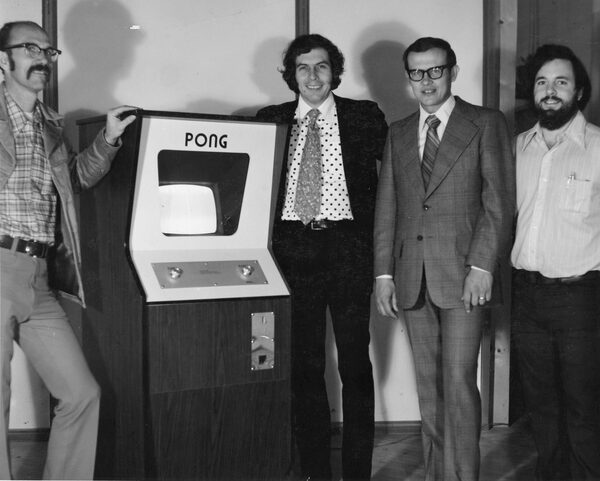
From left, Samuel F. (Ted) Dabney Nolan Bushnell, Fred Marincic and Allan Alcorn in 1973 with a Pong console at the Atari offices in Santa Clara, Calif.AL ALCORN/The New York Times News Service
Samuel F. Dabney, an electrical engineer who laid the groundwork for the modern video game industry as a co-founder of Atari and helped create the hit console game Pong, died May 26 at his home in Clearlake, Calif. He was 81.
The cause was esophageal cancer, his wife, Carolyn Dabney, said.
Mr. Dabney, known as Ted, brought arcade video games to the world with Atari, a startup he and a partner, Nolan Bushnell, founded in Sunnyvale, Calif., in the early 1970s.
At a time when computers could cost hundreds of thousands of dollars apiece, Mr. Dabney spurned them altogether. Instead he tinkered in his workshop and used plywood and fake mahogany panelling to build Atari’s first consoles.
Mr. Dabney used cheap television components to create an interactive motion system and, in 1971, the world’s first commercial video game, Computer Space. Although the game was a failure, it was followed the next year by Pong, a simple yet beguiling game in which short vertical lines bat a ricocheting dot back and forth to the sound of beep tones.
Samuel Dabney Jr., was born in San Francisco on May 2, 1937. His parents, Irma and Samuel Dabney, divorced when he was young, and he was raised by his father, an accountant. A brother, Doug, died in 2013.
He graduated from San Mateo High School before joining the Marine Corps in 1955. He learned engineering at the Navy’s electronics school on Treasure Island in the San Francisco Bay and at its radio relay school in San Diego, according to video game historian Leonard Herman, who wrote a rare profile of Mr. Dabney in 2009 for the British games magazine Edge.
Mr. Dabney returned to San Francisco after being discharged from the Marines in 1959, and took a job at Bank of America’s research lab. In 1961, he joined the military products team at Ampex, in Redwood City, Calif., which specialized in audio technology.
He shared an office at Ampex with Mr. Bushnell, a charismatic engineer who was struck by Mr. Dabney’s pure love of engineering.
“He was just all about ‘Let’s get it done,’” Mr. Bushnell said. “He was the kindest. He didn’t have an ego.”
The men found inspiration in a computer system they had seen at the Stanford Artificial Intelligence Laboratory. They left Ampex together in 1971 and started Atari.
While creating their first game, Computer Space, Mr. Dabney made his breakthrough video circuitry system.
Thanks to the circuitry he developed, the game could be housed in a small cabinet that could be slid in next to pinball machines in bars. The cabinet became an industry standard that endures to this day.
After Computer Space flopped, Mr. Bushnell directed Alcorn to build a table tennis game using Mr. Dabney’s circuitry.
It was an instant success.
As the company grew, the relationship soured between its two founders. Mr. Dabney left Atari in 1973, selling his portion to Mr. Bushnell for US$250,000.
Mr. Dabney later helped Mr. Bushnell with another venture: a restaurant that combined food, animated entertainment and an arcade. Mr. Dabney’s contribution was a system for alerting patrons when their orders were ready. The restaurant was called Chuck E. Cheese’s Pizza Time Theater.
In addition to Carolyn Dabney, Mr. Dabney leaves two daughters from his first marriage to Joan Wahrmund: Pamela Dabney of San Mateo, and Terri Dabney of Paradise, Calif. Mr. Dabney’s marriage to Ms. Wahrmund ended in divorce.